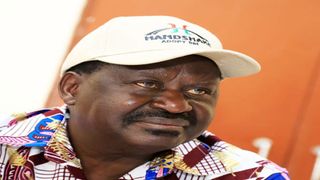
ODM leader Raila Odinga.
| Jeff Angote | Nation Media GroupPolitics
Premium
Raila’s big ODM elections gamble
The decision by ODM leader Raila Odinga to call for party elections to pick a presidential candidate will make or break his 2022 run if past events are anything to go by.
On Tuesday, the party said it will put up advertisements calling for prospective candidates who want to be its flagbearer to apply.
“The board shall advertise in both print and electronic media within the next three days,” read the party’s resolutions that were released by party-secretary general Edwin Sifuna.
The party also plans to revamp the grassroots elections through harmonisation of processes to fill existing gaps in party leadership at ward, branch and county level. The board shall release a timetable of the exercise in one week.
But the decision by Mr Odinga, though fraught with political risks, may also have benefits.
The process may be infiltrated by rivals, losing candidates may bolt out to rival parties, and any chaos may dent Mr Odinga’s reputation, but a successful election may also inject fresh blood in the party and propel it to its 2022 ambitions.
Political rivals
The first risk is infiltration by political rivals who may plant candidates at both branch and county levels and attempt a coup at the national level.
In 2014, the party attempt to hold elections at the national level flopped after the exercise at Kasarani Sports Complex was disrupted by goons christened “Men in Black”.
But it later emerged that the party delegate list had been infiltrated by the then Jubilee ruling coalition, which was planning to plant its supporters as ODM officials.
Among those accused of being Jubilee moles was the then leading contender for the party’s secretary-general post, Mr Ababu Namwamba, who stunned the party with glitzy campaigns using choppers.
The “Men in Black” fiasco, missing delegates and other logistical hiccups also became a public relations nightmare for ODM and Mr Odinga.
The stakes are even higher this time round as Deputy President William Ruto’s political machinery may want to influence who leads Mr Odinga’s party while a repeat of the violence would paint Mr Odinga as a chaotic leader. If he handpicks officials, Mr Odinga will also be accused of being anti-democracy.
“The problem with party elections is lack of a party register which shows the party members eligible to vote. It is thus easy to influence who gets elected as you will just pay for membership of your supporters and ask them to vote for your candidate,” said Mr Eliud Owalo, a former ODM strategist who now works with Dr Ruto.
Also, any contest for the presidency may give restless second-term ODM governors an excuse to leave the party if they lose the presidential nomination, which they are bound to if Mr Odinga runs again.
Amani National Congress leader Musalia Mudavadi left ODM in 2012 accusing Mr Odinga of elbowing him out of a chance to be the party’s flagbearer.
Already, governors Ali Joho (Mombasa) and Amason Kingi (Kilifi), who are ODM officials, have indicated that they will form a Coast party, complicating matters for Mr Odinga.
Elections
They may use the elections as justification to bolt out.
But the elections can also give Mr Odinga’s party a chance to refresh and inject new blood in its ranks. The party has been accused of picking unpopular candidates, leading to losses in by-elections in its strongholds and the rise of independent candidates during the 2017 elections in places like it’s Nyanza stronghold, which was unheard of in previous elections.
ODM may also use the elections to buttress it’s strategy of propping candidates from various regions to run as party’s flagbearers to consolidate the votes in such areas, then the leaders unite behind Mr Odinga after “losing” the presidential nomination.
In 2007, the strategy was used consolidate Coast under Najib Balala, western under Mudavadi, Mt Kenya under the late Joseph Nyagah and Rift Valley under Ruto. The Pentagon members first ran regional campaigns before consolidating their votes under Mr Odinga.
If ODM decides to go to elections, the next few months will be a make or break moment for the party.





